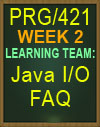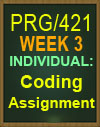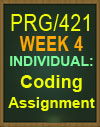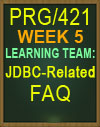|
PRG/421 Java Programming II |
|
|
Or you may purchase UOP Tutorials by the Week below... |
|
|
|
|
PRG/421 WEEK 1
All Week 1 Tutorials listed below are included in purchase!! A+ Work!
Learning Team: Set Up an FAQ
Instructions:
Each week during this course, you will be working with your teammates
to create a Java™ FAQ, or frequently asked questions, list with
answers. The audience for your Java™ FAQ will be other Java
students.
FAQs are extremely common in business and technology today. They
answer important questions in an informal, quick answer format for a
variety of audiences, from customers to partners to internal
stakeholders.
Each week, your team will be assigned Java™-related questions to
research and answer in FAQ format. Members of your group will
research the answers to each week's questions and edit each other's
work, so that at the end of the course your team's FAQs are all
answered clearly, economically, and accurately, with no misspellings or
punctuation errors.
For this week's Learning Team assignment, review the example FAQ, "Frequently Asked OWL Questions (FAQs)," and notice the following
formatting guidelines, all of which are designed to make reading an
FAQ easy for online readers:
- Title appears at top of the FAQ, followed by contributors and "last
edited" date
- Questions appear bolded and two font sizes larger than answers
- A double space appears between each question and answer
- Answers appear beneath corresponding questions
- Both questions and answers are short, direct, and clear. The text is
not meant to impress with fancy words or to be exhaustive; rather, it is
written the way one professional might advise a colleague, using
second person ("you") and providing clear, specific definitions, advice,
and links to extended definitions or examples where appropriate.
Complete this Learning Team assignment by doing the following as a
team:
- Decide which of your team's members will be responsible for
submitting the team's Collaborative FAQ document each week.
- Create a Microsoft® Word document with the title "Java Frequently
Asked Questions (FAQ)."
- Each group member should add his or her name to a contributor list
beneath the FAQ title.
The team member responsible for submitting the team's work will
submit the formatted FAQ document, which will only contain the title
and contributor names at this time, to the Assignment Files tab.
Individual: Week One Analyze Assignment
Includes Instructor Feedback
The purpose of creating an abstract class is to model an abstract
situation.
Example:
You work for a company that has different types of customers:
domestic, international, business partners, individuals, and so on. It well
may be useful for you to "abstract out" all the information that is
common to all of your customers, such as name, customer number,
order history, etc., but also keep track of the information that is specific
to different classes of customer. For example, you may want to keep
track of additional information for international customers so that you
can handle exchange rates and customs-related activities, or you may
want to keep track of additional tax-, company-, and department-related
information for business customers.
Modeling all these customers as one abstract class ("Customer") from
which many specialized customer classes derive or inherit
("InternationalCustomer," "BusinessCustomer," etc.) will allow you to
define all of that information your customers have in common and put it
in the "Customer" class, and when you derive your specialized
customer classes from the abstract Customer class you will be able to
reuse all of those abstract data/methods.This approach reduces the
coding you have to do which, in turn, reduces the probability of errors
you will make. It also allows you, as a programmer, to reduce the cost
of producing and maintaining the program.
In this assignment, you will analyze Java™ code that declares one
abstract class and derives three concrete classes from that one
abstract class. You will read through the code and predict the output of
the program.
Read through the linked Java™ code carefully.
Predict the result of running the Java™ code.
Write your prediction into
a Microsoft® Word document, focusing specifically on what text you
think will appear on the console after running the Java™ code.
In the same Word document, answer the following question:
- Why would a programmer choose to define a method in an abstract
class, such as the Animal constructor method or the getName() method
in the linked code example, as opposed to defining a method as
abstract, such as the makeSound() method in the linked example?
Submit your Word document to the Assignment Files tab.
Individual: Week One Coding Assignment
Includes Instructor Feedback
For this assignment, you will modify existing code to create a single
Java™ program named BicycleDemo.java that incorporates the
following:
- An abstract Bicycle class that contains private data relevant to all
types of bicycles (cadence, speed, and gear) in addition to one new
static variable: bicycleCount. The private data must be made visible via
public getter and setter methods; the static variable must be
set/manipulated in the Bicycle constructor and made visible via a public
getter method.
- Two concrete classes named MountainBike and RoadBike, both of
which derive from the abstract Bicycle class and both of which add their
own class-specific data and getter/setter methods.
Read through the "Lesson: Object-Oriented Programming Concepts" on
The Java™ Tutorials website.
Download the linked Bicycle class, or cut-and-paste it at the top of a
new Java™ project named BicycleDemo.
Download the linked BicycleDemo class, or cut-and-paste it beneath
the Bicycle class in the BicycleDemo.java file.
Optionally, review this week's Individual "Week One Analyze
Assignment," to refresh your understanding of how to code derived
classes.
Adapt the Bicycle class by cutting and pasting the class into the
NetBeans editor and completing the following:
- Change the Bicycle class to be an abstract class.
- Add a private variable of type integer named bicycleCount, and
initialize this variable to 0.
- Change the Bicycle constructor to add 1 to the bicycleCount each
time a new object of type Bicycle is created.
- Add a public getter method to return the current value of
bicycleCount.
- Derive two classes from Bicycle: MountainBike and RoadBike. To
the MountainBike class, add the private variables tireTread (String) and
mountainRating (int). To the RoadBike class, add the private variable
maximumMPH (int).
Using the NetBeans editor, adapt the BicycleDemo class as follows:
• Create two instances each of MountainBike and RoadBike.
• Display the value of bicycleCount on the console.
Comment each line of code you add to explain what you added and
why. Be sure to include a header comment that includes the name of
the program, your name, PRG/421, and the date.
Rename your JAVA file to have a .txt file extension.
Submit your TXT file to the Assignment Files tab.
Discussion Question: Data Hiding
Data hiding is the way in which programmers implement encapsulation. Java™ programmers use the keywords
private and protected to control what data is visible outside of a class; in other words, to control what code can access
and manipulate class data.
Read Table 1-2, "Determining Access to Class Members," in "Java - Protected Members Accessed in Derived Class
Using Base Class Instance" on the Stack Overflow website.
Note: This table is similar, though not identical, to Table 1-1, "Access Modifiers," in Ch. 1, "Advanced Class Design," of
OCP: Oracle® Certified Professional Java® SE 8 Programmer II Study Guide.
Discuss the following by posting to the discussion area:
- If Class A contains private data and Class B inherits from Class A, is it possible to make Class A's private data
visible to Class B? If so, how? Be sure to provide reasons for your answer based on this week's textbook readings or
this week's assignment code.
Supporting Activity: Static Variables and Methods
For this assignment, you will predict the output of Java™ code that includes a static (class) variable accessed by a
static method. Completing this assignment will help you understand the utility of using static variables and methods, as
well as recognize the syntax required to create static variables and methods.
Read through the linked Java™ code carefully.
Predict the result of running the Java™ code; specifically, what text you think will appear on the console after running
the Java™ code. Can you think of other uses for static variables and methods? In other words, can you think of other
situations in which you might want all instances of a class to be able to access a single class variable?
|
|
|
|
|
PRG/421 Week 2
All Week 2 Tutorials listed below are included in purchase!!
Learning Team: Java I/O FAQ
Instructions:
The purpose of this activity is to define and explain the syntax required
for data output.
Continue working as a team on your FAQ document by answering the
following questions and adding them to the Microsoft® Word document
you started in your Week One Learning Team assignment, "Set Up a
FAQ":
• What is the syntax for writing data to a file?
• What is the syntax forwrapping file output in an exception handler?
Note: You may want to review Ch. 8, "IO," in OCP: Oracle® Certified
Professional Java SE 8 Programmer II Study Guide: Exam 1Z0-809
for help answering these questions.
The team member responsible for submitting the team's work will
submit the formatted FAQ document containing this week's questions
and answers to the Assignment Files tab.
Individual: Week Two Analyze Assignment
Instructions:
For this assignment, you will analyze Java™ that presents instructional
text on the console, accepts user input, and then create a file based
on that user input.
Read the linked Java™ code carefully.
Then, answer the following questions in a Microsoft® Word file:
- As you run the program in NetBeans the first time, at the prompt (the
program will pause for input) type abc Return def Return ghi
Ctrl+Shift+Del. What is the result?
- As you run the program in NetBeans the second time, at the prompt
(the program will pause for input) type 123 Ctrl+Shift +Del. What is the
result?
- What happens if the file Data.txt already exists when you run the
program?
- What happens if the file Data.txt does not already exist when you run
the program?
Submit your Word file to the Assignment Files tab.
Individual: Week Two Coding Assignment
Instructions:
For this assignment, you will build on "starter" code to create a Java™
program that prompts the user for input, accepts user input, and
produces both console and file output.
Copy the linked code to a JAVA file.
Add Java® code based on the comments inside the code.
Note: Refer to this week's Individual "Week Two Analyze Assignment" for model code you can adapt to meet this assignment's requirements.
Test, debug, and run your code using the NetBeans editor to make sure
it meets the program requirements.
Save your JAVA file with a .txt extension.
Submit your TXT file to the Assignment Files tab.
Discussion Question: Data Conversion
(3 Answers Included)
Accepting input and producing output virtually always requires data conversion. Because Java™ students new to I/O
are often surprised at the steps necessary to read data and then put it in a form that can actually be used, the purpose
of this discussion is to experiment with data conversion techniques and share the issues that arise to arrive at a better
understanding of the critical role data conversion plays in Java I/O.
Copy and paste the linked code into a Java™ program (or rename the file using a .java extension) and run it in
NetBeans. The purpose of the program is to calculate a salesperson's total annual compensation. The program asks
the user for the total amount dollar amount of sales for a year, and then uses that input to make calculations.
Post your results after running the program to the discussion area.
Discuss with your classmates what errors were produced, what could have caused the errors, and how this code can
be fixed. Is there an approach you learned from this code that you can apply to all those situations in which you need
to read data and convert it to a usable form?
Note: To interpret your results, you may want to refer to Ch. 5, "Dates, Strings, and Localization," of OCP: Oracle®
Certified Professional Java® SE8, Programmer II Study Guide.
Discussion Question: Choosing a Data Output Option
(2 Answers Included)
Before you can perform data output, you must first decide the form in which you want the output data to appear.
Onscreen and flat-file output are sometimes appropriate in a small system, such as a modest inventory application in
which updated results display on a screen to be analyzed by a user, and in which output is designed for little more
than backup on a local, secure machine. Displaying information onscreen can be a benefit, since the user does not
have to produce and review a program-generated report, while saving small amounts of data to an easily-read file with
no requirement to manage a database can be the best approach if program requirements do not dictate otherwise.
However, in high-volume scenarios where one program "feeds" large amounts of data to another program, console output and flat-file data storage may not make practical sense.
Post to the discussion area descriptions of at least two scenarios for which console or flat file output would not be
appropriate. For each scenario, describe why console/flat file output would not be appropriate, and identify an
alternative approach that might make more sense.
Review your classmates' posts, then explain what characteristics the scenarios of your classmates and you described
share. In general, for what types of programming scenarios are flat file/console output inappropriate?
|
|
|
|
|
PRG/421 Week 3
All Week 3 Tutorials listed below are included in purchase!!
Learning Team: Stream Manipulation and Generics FAQ
Instructions:
The purpose of this assignment is to identify the syntax for a common
data conversion or manipulation method and differentiate the syntax
and intent of implementing a generic class versus an abstract class.
Continue working as a team on your FAQ document by answering the
following questions and adding them to the Microsoft® Word document
you started in Week One and continued in your Week Two Learning
Team assignment, "Java I/O FAQ":
- The peek() method retrieves, but does not remove, the first element
of a list. What is the syntax for peek()?
- What is the difference between a generic class and an abstract
class?
The team member responsible for submitting the team's work will
submit the formatted FAQ document containing this week's questions
and answers to the Assignment Files tab.
Individual: Week Three Analyze Assignment
Instructions:
For this assignment, you will analyze code that uses a file input stream
and a file output stream.
Read through the linked Java™ code.
In a Microsoft® Word document, answer the following questions:
- Could this program be run as is? If not, what is it lacking?
- Does this program modify the contents of an input stream? In what
way?
- What are the results of running this code?
Submit your completed Word document to the Assignment Files tab.
Individual: Week Three Coding Assignment
Instructions:
For this assignment, you will develop "starter" code. After you finish,
your code should access an existing text file that you have created,
create an input stream, read the contents of the text flie, sort and store
the contents of the text file into an ArrayList, then write the sorted
contents via an ouput stream to a separate output text file.
Copy and paste the following Java™ code into a JAVA source file in
NetBeans:
import java.io.BufferedReader;
import java.io.BufferedWriter;
public class Datasort {
public static void main (String [] args) {
File fin = // input file
File fout = // create an out file
// Java FileInputStream class obtains input bytes from a file
FileInputStream fis = new FileInputStream(fin);
// buffering characters so as to provide for the efficient reading of
characters, arrays, and lines
BufferedReader in = new BufferedReader(new
InputStreamReader(fis));
// declare an array in-line, ready for the sort
String aLine;
ArrayList<String> al = new ArrayList<String> ();
int i = 0;
while ((aLine = in.readLine()) != null) {
// set the sort for values is greater than 0
Collections.sort(al); // sorted content to the output file
{
System.out.println(s);
}
// close the 2 files
}}
Add code as indicated in the comments.
Note: Refer to this week's Individual assignment, "Week Three Analyze
Assignment," and to Ch. 8, "IO," in OCP: Oracle® Certified Professional
Java® SE 8 Programmer II Study Guide.
Run and debug your modified program in NetBeans until it satisfies the
requirements described above.
Save your finalized JAVA file with a .txt extension.
Submit your TXT file to the Assignment Files tab.
Discussion Question: Benefits of Generics
(5 Answers Included)
The purpose of this discussion is to describe the difference between implementing a class as an abstract class (i.e., a
class from which concrete classes can be derived) and a generic class (i.e., a class from which different types of
classes can be derived).
Discuss the benefits of using a generic class.
Share an example of a real-life situation that would benefit from being modeled as a generic class.
Instructions
Supporting Activity: Abstract Methods and Classes
(2 Answers Included)
The purpose of this activity is to understand the syntax necessary to declare and implement abstract methods and
classes.
A method declared without any body within an abstract class is called an abstract method. The body of an abstract
method must be defined by its subclass. Abstract methods can never be declared final or static, and any class that
extends an abstract class must implement all the abstract methods declared by the super class. Abstract methods are
useful in situations when two or more subclasses are expected to do a similar thing in different ways, extending the
same abstract class by providing different implementations of the same abstract methods.
For this activity, you will practice defining an abstract method in one class (class A) and implementing that method in a
derived class (class B).
Copy and paste the following code into a JAVA source file in NetBeans; note the abstract and extends keywords in the
source:
abstract class A {
abstract void demoabst();
}
class B extends A { // subclass B derives from A
void demoabst () {
System.out.println("This is a code demo.");
}
public static void main(String[] args) {
B b = new B(); // class B reference and object
b. demoabst (); // reference demoabst object
}}
Run and debug the JAVA file in NetBeans
|
|
|
|
|
PRG/421 Week 4
All Week 4 Tutorials listed below are included in purchase!!
Learning Team: Concurrency and Localization FAQ
Instructions:
The purpose of this assignment is to define key components of
concurrency and to identify the purpose and benefit of localization,
which is implemented (in part) using the Locale object.
Continue working as a team on your FAQ document by answering the
following questions and adding them to the Microsoft® Word document
you started in Week One and continued in your Week Three Learning
Team assignment, "Stream Manipulation and Generics FAQ":
• What is a thread?
• What is a process?
• What is deadlock?
• What is the purpose and benefit of localization?
The team member responsible for submitting the team's work will
submit the formatted FAQ document containing this week's questions
and answers to the Assignment Files tab.
Individual: Week Four Analyze Assignment
Instructions:
Deadlock occurs when no processing can occur because two
processes that are waiting for each other to finish. For example,
imagine that two processes need access to a file or database table row
in order to complete, but both processes are attempting to access that
resource at the same time. Neither process can complete without the
other releasing access to the required resource, so the result is
deadlock.
Read and analyze code in the linked document that spawns two
different threads at the same time.
In a Microsoft® Word file, predict the results of executing the program,
and identify whether a deadlock or starvation event will occur and, if so,
at what point in the code.
Submit your Word file to the Assignment Files tab.
Individual: Week Four Coding Assignment
Instructions:
For this assignment, you will develop Java™ code that relies on
localization to format currencies and dates.
In NetBeans, copy the linked code to a file named "Startercode.java".
Read through the code carefully and replace all occurrences of "___?___" with Java™ code.
Note: Refer to "Working with Dates and Times" in Ch. 5, "Dates,
Strings, and Localization," in OCP: Oracle® Certified Professional Java®
SE 8 Programmer II Study Guide for help.
Run and debug your JAVA file to ensure that your solution works.
Save your JAVA file with a .txt extension.
Submit your TXT file to the Assignment Files tab.
Discussion Question: Benefits and Drawbacks of Concurrency
(4 Answers Included)
The purpose of this discussion is to explore concurrency, which refers to threads that run alongside each other during
program execution, as opposed to running serially, or one after the other, and to discuss potential drawbacks and
problems associated with concurrency.
Java™ provides built-in support for concurrent programming by allowing the running of multiple threads concurrently
within a single program. A thread, also called a lightweight process, is a single sequential flow of programming
operations with a definite beginning and end. During the lifetime of a thread, there is only a single point of execution. A
thread by itself is not a program, because it cannot run on its own, instead all threads must run within a program.
Research and discuss with your classmates the benefits of concurrency in Java™. What are the potential drawbacks?
Supporting Activity: Localization
(3 Answers Included)
The purpose of this activity is to provide you with an explanation for, and some experimentation with, the concept of
localization via the Locale object.
Localization is the process of adapting a program so that it displays information in the way local users need to see it,
and is important for any program running on the web where users from virtually any country in the world can access it.
A program that has been effectively localized displays currency in pounds and dates in day/month/year format to
United Kingdom audiences, currency in dollars and dates in month/day/year format to United States audiences, etc.
Localization is particularly significant in that it allows for organizing all user-facing text so that it display text in different
languages, as necessary.
Note: This course does not address localization in detail, however it does introduce the topic and demonstrate how
setting a Locale object allows Java™ programmers to take advantage of pre-built formatting.
For this supporting activity, you will run an existing Java™ program to see how changing the Locale object
automatically changes date formats.
Download the linked Java™ file, or cut-and-paste it into a new Java™ project in NetBeans using a name of your
choosing.
Examine the Java™ code, paying special attention to the main() method, in which three Locale objects are created:
one for France, one for Germany, and one for the United States. Notice that passing different Locale objects to the
same methods (e.g., showDateStyles(), showTimeStyles(), and showBothStyles()) results in a customized display.
Note: Refer to the linked list of standardized codes to see which codes represent which countries.
Insert the following code at the beginning of the main() method, just after the opening curly brace:
Date now = new Date();
System.out.println("Here is default date format: " +
DateFormat.getInstance().format(now));
Save the program, and run it in NetBeans again. What locale does the Java™ runtime environment assume by
default: U.S. or European? (Hint: Typically, the Java™ runtime environment sets the default locale on download/install
based on your computer system.)
|
|
|
|
|
PRG/421 Week 5
All Week 5 Tutorials listed below are included in purchase!!
Learning Team: JDBC-Related FAQ
Instructions:
The purpose of this assignment is to identify the JDBC API syntax
necessary for establishing a connection to a database, retrieving data
from a database, processing the data, and presenting a subset of the
data on the console. Familiarity with the syntax for all of these methods
will be required in this week's Individual, "Week Five Coding
Assignment."
Continue working as a team on your FAQ document by answering the
following questions and adding them to the Microsoft® Word document
you started in Week One and continued in your Week Four Learning
Team assignment, "Concurrency and Localization FAQ":
The team member responsible for submitting the team's work will
submit the formatted FAQ document containing this week's questions
and answers to the Assignment Files tab.
Individual: Week Five Analyze Assignment
Instructions:
For this assignment, you will analyze code that uses the JDBC API to
access a database, retrieve data, and compose output based on that
data. You will then comment the code to reflect the purpose and
expected results of the code.
Download the linked TXT file, and read through the Java™ code
carefully.
Add your name, instructor's name, and today's date to the header
comment.
Replace the five comment placeholders with succinct comments that
explain and predict the results of the Java™ statement(s) that directly
follow the comment placeholders.
Individual: Week Five Coding Assignment
Instructions:
For this assignment, you will create Java™ code that accesses a relational database, requests data, and then analyzes and displays a portion of that data.
Imagine a MySQL relational database schema named COMPANY_DB containing two tables, employee_table and payroll_table, such that the records in each of the tables is as follows:
Emp id |
FName |
LNname |
Addr |
City |
State |
Zip |
100 |
Jack |
Smith |
123 North |
Topeka |
KS |
66603 |
101 |
Joe |
Apple |
4 Street |
Denver |
CO |
80202 |
111 |
Nancy |
Good |
45 SW |
Hartford |
CT |
06103 |
121 |
Tom |
Whatever |
89 NE |
Dover |
DE |
19901 |
122 |
Jim |
Thompson |
789 W 95 |
Albany |
NY |
12207 |
123 |
Tommy |
Boyson |
154 Bolt |
Boston |
MA |
02201 |
125 |
John |
Jones |
47 West |
Lincoln |
NE |
68502 |
Emp id |
Paysch |
401k |
Spouse |
100 |
BiWk |
yes |
yes |
101 |
BiWk |
yes |
yes |
111 |
Monthly |
no |
no |
121 |
Wkly |
pending |
yes |
122 |
Wkly |
yes |
no |
123 |
Monthly |
pending |
no |
125 |
Monthly |
no |
yes |
The credentials you will need to access the database which holds both of the tables are as follows:
- Host string = localhost:3306
- Username = student
- Password = prg421
Copy and paste the linked Java™ "starter" code into the NetBeans editor and save as a JAVA file.
Add Java™ statements to the file to accomplish the following:
- Establish a connection to the database
- Query the database, joining the two tables on the Emp_id field
- Display your name and today's date on the console along with the following returned database results:
- employee identification number
- first and last name
- state
- payroll schedule
- 401k plan
- Close the database connection
Identify and correct any compile-time errors that exist in the starter code.
Note: Because you will not be connecting to an actual database, some compiler errors will remain.
After you finish, rename your JAVA file with a .txt extension using the following naming convention:
- PRG421_Week5CodingAssignment_LastnameFirstname.txt.
Submit your TXT file to the Assignment Files tab.
Discussion Question: Databases Accessible via JDBC
(5 Answers Included)
The purpose of this discussion is to identify the purpose and utility of JDBC to Java™ programmers, including the
data formats that JDBC allows Java™ programmers to interact with. Research and discuss the differences between a flat database and a relational database. Does JDBC provide a way
for Java™ programmers to access flat databases, relational databases, or both? What specific relational databases
can be accessed via JDBC?
Supporting Activity: Basic SQL Statements
(5 Answers Included)
The purpose of this activity is for you to familiarize yourself with the basics of SQL syntax, which is required for
retrieving data from a database using JDBC.
As a Java™ programmer, you do not have to be an expert at Structured Query Language (SQL), the language used to
access and manipulate data stored in relational databases. However, to retrieve or update data in a relational
database, you will need a passing familiarity with SQL statements, because you will need to pass these SQL
statements as arguments to one or more JDBC API calls and should understand enough to see the issue if they do not
work.
Familiarize yourself with basic SQL statements by taking the linked 25-question "W3Schools SQL Quiz." Use the
answers to each quiz question to familiarize yourself with basic SQL query statements and keywords, such as
SELECT and JOIN.
|




















